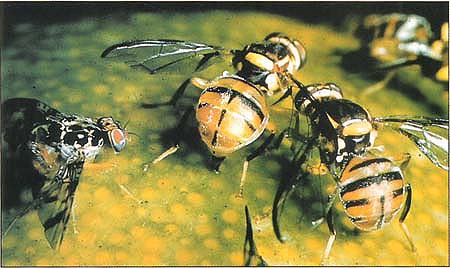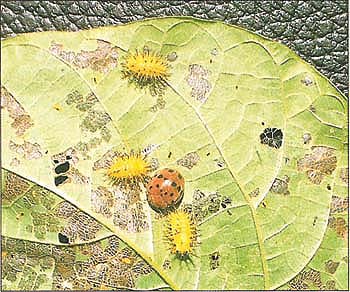All Issues
Plant quarantines: domestic strategies yield to international policies
Publication Information
California Agriculture 46(1):9-10.
Published January 01, 1992
PDF | Citation | Permissions
Abstract
Since 1875, quarantine laws have been enacted to protect domestic agriculture from foreign pests. Today, thanks to efficient agricultural production and swift commodity transport, California growers have access to widespread international markets. Domestic regulatory policies are no longer adequate and must yield to new and developing international regulatory policies. The General Agreement on Tariffs and Trade (GATT) is considering an initiative to harmonize plant quarantine regulations among nations. In addition, development of the “pest-free” zone concept has benefited both exporters and importers.
Full text
Left: Female oriental fruit flies ovipositing in fruit. The fly has invaded California numerous times since the 1960s, and was detected for the first time in the Central Valley in 1991, near Lake Isabella in Kern County. A current infestation is being eradicated in Southern California.
Above: Adult and larval forms of Mexican bean beetle on bean leaf. The beetle is widespread in the eastern U.S., and has invaded and been eradicated from California once.
A plant quarantine is a legal action enacted by a government to prevent or delay the establishment of a plant pest in an area where it does not already occur; or to prevent or delay distribution of a pest in an area where it is does not generally occur. Any of the following can be considered a plant quarantine action: a restriction of the movement of actual, or potential, pests and their carriers; detection operations that target early discovery of incipient infestations; eradication operations; and containment of (incipient) infestations by intensive control, or other measures.
The necessity, domestic or international, for quarantine regulation is based on the following determinations: the identification of exotic pests which could cause unacceptable damage to the agricultural economy, the means and ease of entry, and the options available for prevention, detection and/or treatment.
The concept of quarantine prevention first originated as a public health measure during the 14th century. Ships were detained at port of arrival for a designated period to isolate and identify those passengers possibly carrying epidemic diseases.
Although laws directed at plant pest suppression were established as early as the 17th century, it was not until agricultural production shifted from a self-sufficient system to actual commercial production in the 1800s that exports of American products, and their associated pests, resulted in the first known plant quarantine laws. These were established in 1875 by Germany and France against two native American pests, the Colorado potato beetle and grape phylloxera.
In 1899, California enacted the first known state quarantine law which specifically provided for protection of the state's horticulture, prevention of the introduction of foreign pests, and enforcement of its provisions.
Principles governing plant quarantine actions can be found in the National Plant Board's Principles of Plant Quarantine. These principles require plant quarantine regulations to adhere to the following guidelines: target only those pests reasonably expected to pose a threat to “substantial interests,” represent the least intrusive and most economical measure available, and be enforceable. In addition, any actions imposed must be adequate to accomplish the goals of the quarantine action without being unnecessarily restrictive.
Justification for the use of plant quarantines as a pest prevention measure can be found by studying those regions that have experienced severe crop losses or damage to the environment due to the inadvertent introduction of exotic pests. Examples in the U.S. are cotton boll weevil in the Southeast and gypsy moth in the Northeast. To date, California has avoided many of these experiences by using plant quarantines. This policy of pest exclusion was reaffirmed following California's 1980-82 Mediterranean Fruit Fly Project when Governor Jerry Brown's Pest Response Task Force concluded that “the clearest lesson learned…is that it is normally much more cost effective to fight invading pests before they establish a firm beachhead…that preventive measures are generally more cost effective than pest eradication and control.”
Today, the California Department and Food and Agriculture (CDFA), together with California's county agricultural commissioners, administer and operate the state's pest prevention system. This system, which reflects the general categories of plant quarantine, consists of pest exclusion, detection, eradication, and public information and education. The authority for this system is found in the California Food and Agricultural Code which mandates the director to “prevent the introduction and spread of injurious insects or animal pests, plant diseases, and noxious weeds.”
The increased efficiency of agricultural production, coupled with the speed and efficiency with which commodities may now be transported, and the continued integration of the global marketplace, have resulted in the exploration and establishment of many, new, agricultural marketing opportunities. Indeed, a recent issue of California Agriculture (Sept.-Oct. 1991) focused on the potential implications for California's agriculture from free trade negotiations in progress worldwide, based on the statistic that one out of every four farm acres in California is dedicated to agricultural exports. Consequently, domestic regulatory policies are no longer sufficient and must necessarily yield to development of international regulatory policies.
GATT negotiations
To address this need, in 1989, the General Agreement on Tariffs and Trade (GATT), a world organization established as a forum for developing rules concerning international trade, began considering an initiative to harmonize, or make equivalent, plant quarantine regulations. When finalized, this agreement should strengthen the International Plant Protection Convention (IPPC) document, which, under the United Nation's Food and Agriculture Organization, provides guidance to member nations concerning phytosanitary issues. In addition, it should mitigate the tendency for governments to arbitrarily use plant quarantines as trade barriers. Currently under development are a harmonized pest risk analysis system, plant quarantine principles and plant quarantine procedures.
“Pest-free” zones
The formative stages of this policy development offer regulatory officials the opportunity to propose and evaluate new and innovative solutions to current phytosanitary challenges. One such concept being used more frequently is that of the “pest-free” zone as a means of qualifying designated commodities for origin certification. The elimination of pest problems at origin provides more security for the receivers and more latitude for shippers marketing perishable commodities. These areas, or zones, consist of locations determined to be free of the target pest and additionally serve as a buffer against its natural spread, therefore allowing the exportation of host products without the otherwise required quarantine treatments.
This concept works well when the following conditions apply: the importing country ascertains that the target pest poses a significant quarantine risk; inspection does not provide assurance of a pest-free product; quarantine treatment is not an available or acceptable alternative; and the establishment of a pest-free area is feasible. Protocols for establishing such areas include: appropriate surveys; required actions to be taken if the target pest is detected within the area; procedures for sampling, marking, certifying and safeguarding export products, and a documented history of pest-free status. California fully supports this concept, provided such protocols can be established for the targeted pest and their enforcement is feasible.
Pest-free zone agreements presently in place include: California's master permit with the state of Florida to allow shipment of certain citrus fruit into California from areas certified free of Caribbean fruit fly (caribfly) and citrus canker, without prior fumigation or cold treatment; the USDA's agreement with Chile to provide for movement of Mediterranean fruit fly (medfly) host fruit from areas within the country designated to be free of medfly and establishment of a Mexican fruit fly-free zone in the state of Sonora originally to facilitate the movement of mangoes, but later expanded to include other specified host fruit, from Mexico to the United States, as part of previous bilateral negotiations between the two countries.
Under these agreements the exporting country, or state, is allowed to ship specified, untreated, fruits to the authorized destination provided: regular surveys show that the designated production area remains free from infestation by the target pest, or pests, and that the designated area is made ineligible for export upon the discovery of any infestation of the targeted pest, or pests, until eradication measures have been declared successful.
For example, under the caribfly agreement, McPhail traps are placed within the designated production areas at a specified rate, these traps are inspected on a weekly basis, and a 1.5-mile buffer zone surrounding the production area is kept host free, or regularly sprayed with malathion and bait, before and throughout harvest. California is immediately notified upon detection of an caribfly infestation within a production area, and that area is immediately subjected to eradication treatments and removed from the list of caribfly-free areas until eradication is declared.
To date, the pest-free area concept has benefitted both exporter and importer. Further development of such creative strategies should be encouraged as a means of facilitating international plant quarantine policies and mitigating inclinations to use plant quarantines as nontariff trade barriers.






